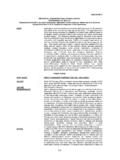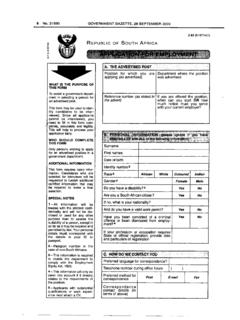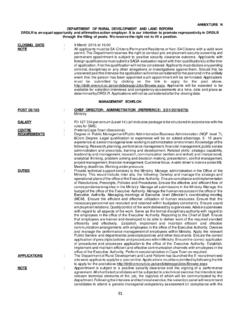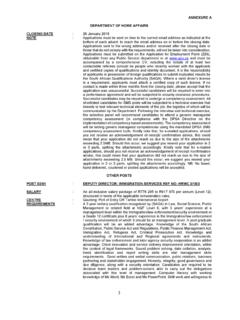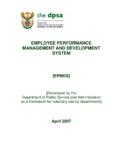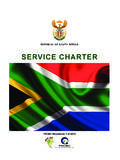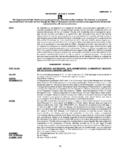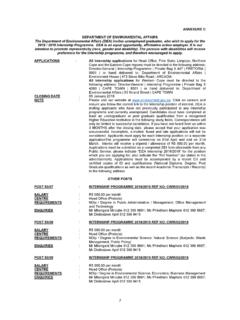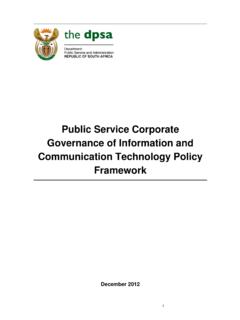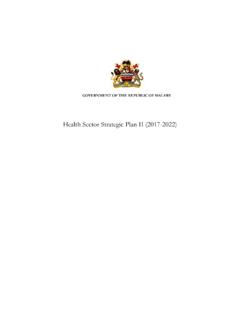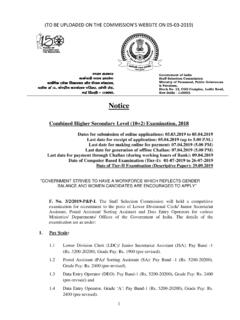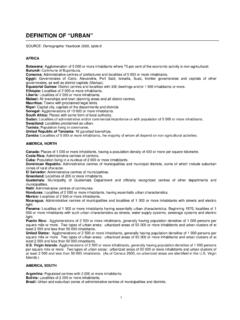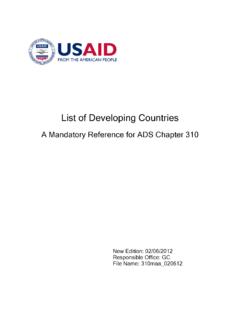Transcription of The Machinery of Government - Structure and Functions of ...
1 The Machinery of Government Structure and Functions of Government May 2003. Department of Public Service and Administration 1. Acknowledgments The team would like to thank the following persons for contributions, inputs, and direction given in the development of the booklet: Mr. Muthanyi Robinson Ramaite, Director General: Department of Public Service and Administration, for conceptualising the project and his overall guidance Government departments, in particular the Presidency, Treasury, Department of Provincial and Local Government , and various components in the Department of Public Service and Administration, for providing the information Professor Tebogo Job Mokgoro, for his expert advice on the content and logical flow, editing, and final reading of the booklet Prepared and co-ordinated by: Learning and Knowledge Management Unit in the Service Delivery Improvement Branch of the Department of Public Service and Administration 2.
2 Foreword by Hon. Minister Geraldine Fraser-Moleketi Minister for Public Service and Administration In the latter half of the twentieth century, many countries in the world have enthusiastically taken on the daunting and challenging task of reforming their governments along the principles of good governance. In South Africa the post-1994 era has seen many rigorous structural changes being introduced as part of Government 's transformational drive to adapt and cope with the many dynamic contemporary challenges. New and more focused entities or agencies were and continue to be created to complement the already existing ones. In addition, already existing structures have been and continue to be revisited and assessed while new policies and strategies are being put in place in key areas, such as human resource management, to achieve good governance.
3 In this booklet we try to capture, in brief and simple terms, the Structure of the Government of South Africa, that is, its three spheres and other important bodies such as parastatals, statutory commissions, public entities, and research institutions. We also look at the various elements that contribute individually as cogs in the overall wheel of the service delivery Machinery in the country. In the process we pay particular attention to some important systems such as budgeting, law making and the disciplinary system in the public service. We believe that this booklet will go a long way to guide and inform citizens about the role of the various organs of the state and what part each one of them plays in service delivery.
4 Also, public officials, particularly the new recruits, as well as officials from other sectors that are also participating in service delivery will hopefully benefit from this booklet. From the snapshot of the Government that this booklet offers, they will be able to identify and locate their role firstly as individuals and secondly within their institution within the overall Machinery of Government . Geraldine Fraser-Moleketi Minister for Public Service and Administration 3. TABLE OF. CONTENTS. CHAPTER 1. 1. An Introduction The Meaning of Government 11. Background 11. CHAPTER 2. 2. The Constitution and the System of Government System of Government 14. Spheres of Government 15.
5 National Government 15. President 15. Cabinet 15. Government Departments 16. Parliament 16. National Assembly 16. National Council of Provinces 17. Provincial Government 17. Provincial legislature 17. Provincial executive 18. Local Government 18. Municipalities 19. Executive 19. Traditional leaders 20. Judiciary 20. Constitutional court 21. Supreme court of appeal 21. High Courts 21. Magistrate courts 22. Other courts 22. Constitutional Bodies 23. Public Protector 23. Human Rights Commission 23. Commission for the Promotion and Protection of the Rights of Cultural, Religious and Linguistic Communities. 24. Commission on Gender Equality 24. Auditor General 24. 4. Electoral Commission 25.
6 Independent Communication Authority of South Africa 25. Financial and Fiscal Commission 25. Central Bank 25. CHAPTER 3. 3. The Intergovernmental System in South Africa Constitutional framework regarding the multi-sphere system of Government 27. Distinctive 27. Interdependent 28. Interrelated 28. Intergovernmental fiscal system 28. The division of revenue between the spheres of Government 29. Intergovernmental structures 31. Cooperation between the structures 31. The Intergovernmental forum 31. Intergovernmental relations committees of Ministers and Members of provincial councils (MinMec's) 32. Organized local Government 32. Forum for South African Directors-General (FOSAD) 33.
7 Intergovernmental relations Structure within the legislative branch of Government 33. Integrated governance issues 34. Planning framework 34. Cabinet and DG Clusters 35. President's Coordinating Council 35. Integrated Sustainable Rural Development Program and the Urban Renewal Strategy 37. CHAPTER 4. 4. Law and Policy Making Policy making process 39. Bills 40. Drafting 41. Transforming a bill into an act 41. Bills tabled in Parliament 41. Bills that do not affect the provinces 41. Bills that affect the provinces 42. 5. Bills tabled in a provincial legislature 43. Laws of municipal councils 43. Role of parliamentary committees 43. CHAPTER 5. 5. Integrated Planning Framework & Budgeting Cycle MTSF and MTEF 46.
8 Role of Departments and Provinces in the Planning Framework 46. Planning Cycle Processes 46. Departmental and Provincial Priorities 46. Cluster Level Priorities 48. FOSAD 48. Cabinet Makgotla 48. Consolidation of MTSF for Budget Purposes 48. Budgeting cycle 49. Prioritisation stage 49. Preparation and review of MTEF budget submissions 50. Review of the macroeconomic and fiscal framework and the division of revenue 51. Medium-term allocation process: recommendation stage 51. Medium-term budget policy statement (MTBPS) 52. Medium-term allocation: decision stage 53. Preparation for budget 53. Budget review stage 54. Managing MTSF 54. Transfer of Functions 55. CHAPTER 6. 6. Creating Government Departments & Public Entities Government Departments 57.
9 Creation of a Public Entity 58. Rationale for using agencies 58. Mandates for the creation, listing and classification of National PEs 59. Minister for the Public Service and Administration (MPSA) 59. Minister of Finance (MoF) 59. Process to create PE's 59. 6. CHAPTER 7. 7. The Collective Bargaining Process Composition of the public service 62. Relationship between collective bargaining and cabinet/parliament 62. Relationship between employer and employee 62. Structure of collective bargaining 63. Objectives and Functions of the bargaining council 64. Period of bargaining 65. Roles of different bargaining councils 65. Appointment of representatives and alternates 65. Determination of basis votes 66.
10 Chairperson and vice-chairpersons 66. Secretary and other personnel 67. Decisions of the council 67. Disputes 68. Types of disputes 68. Dispute resolutions Functions of the council 68. Dispute resolution in the public service 68. Amendment of the constitution of the council 69. Communication 69. Consultation 69. Freedom of association 70. CHAPTER 8. 8. Information Management Roles and responsibilities 74. Minister (MPSA) and department of Public Service and Administration (DPSA) 74. Government Chief Information Officer (GCIO) 74. Government Information Technology Officer (GITO) 75. Government Information Technology Officers Council 75. (GITOC). Mission of GITOC 75. Composition 75.
